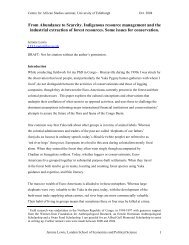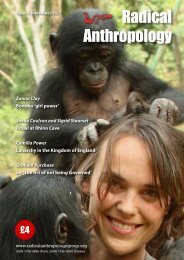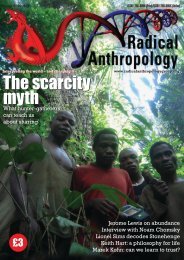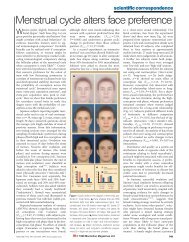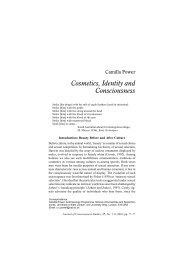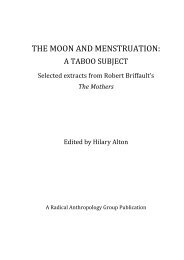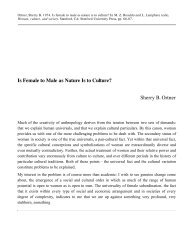Language and life history: A new perspective on the development ...
Language and life history: A new perspective on the development ...
Language and life history: A new perspective on the development ...
- No tags were found...
Create successful ePaper yourself
Turn your PDF publications into a flip-book with our unique Google optimized e-Paper software.
References/Locke & Bogin: <str<strong>on</strong>g>Language</str<strong>on</strong>g> <str<strong>on</strong>g>and</str<strong>on</strong>g> <str<strong>on</strong>g>life</str<strong>on</strong>g> <str<strong>on</strong>g>history</str<strong>on</strong>g>Lakoff, G. & Johns<strong>on</strong>, M. (1980) Metaphors we live by. University of ChicagoPress. [arJLL]Lancaster, J. B. & Lancaster, C. S. (1983) Parental investment: The hominidadaptati<strong>on</strong>. In: How humans adapt, ed. D. J. Ortner, pp. 33–65. Smiths<strong>on</strong>ianInstituti<strong>on</strong> Press. [aJLL, GEW]Langacker, R. (1987) Foundati<strong>on</strong>s of cognitive grammar, vol 1. Stanford UniversityPress. [SJ]Lass, N., Ruscello, D., Bradshaw, K. & Blakenship, B. (1991a) Adolescents’percepti<strong>on</strong>s of normal <str<strong>on</strong>g>and</str<strong>on</strong>g> voice-disordered children. Journal ofCommunicati<strong>on</strong> Disorders 24:267–74. [aJLL]Lass, N. J., Ruscello, D. M., Stout, L. L. & Hoffmann, F. M. (1991b) Peerpercepti<strong>on</strong>s of normal <str<strong>on</strong>g>and</str<strong>on</strong>g> voice-disordered children. Folia Ph<strong>on</strong>iatrica43:29–35. [aJLL]Lee, P. C. & Bowman, J. E. (1995) Influence of ecology <str<strong>on</strong>g>and</str<strong>on</strong>g> energetics <strong>on</strong> primatemo<strong>the</strong>rs <str<strong>on</strong>g>and</str<strong>on</strong>g> infants. In: Mo<strong>the</strong>rhood in human <str<strong>on</strong>g>and</str<strong>on</strong>g> n<strong>on</strong>human primates,ed. C. R. Pryce, R. D. Martin & D. Skuse, pp. 47–58. Karger. [SR]Lee, R. B. (1979a) The !Kung San: Men, women, <str<strong>on</strong>g>and</str<strong>on</strong>g> work in a foraging society.Cambridge University Press. [aJLL](1979b) The Dobe !Kung. Holt, Rinehart <str<strong>on</strong>g>and</str<strong>on</strong>g> Winst<strong>on</strong>. [aJLL]Leigh, S. R. (1996) Evoluti<strong>on</strong> of human growth spurts. American Journal ofAnthropology 101:455–74. [rJLL](2001) The evoluti<strong>on</strong> of human growth. Evoluti<strong>on</strong>ary Anthropology10:223–36. [rJLL]LeMasters, E. E. (1975) Blue-collar aristocrats: Life-styles at a working-classtavern. University of Wisc<strong>on</strong>sin Press. [aJLL]Lenti Boero, D. (1992) Alarm calls in marmots: Evidence for semanticcommunicati<strong>on</strong>. Ethology, Ecology, Evoluti<strong>on</strong> 4(2):125–38. [DLB](1997) Dal pianto alla parola: Una revisi<strong>on</strong>e della letteratura in una prospettivacomparata (From crying to speech: A review of literature in a comparative<str<strong>on</strong>g>perspective</str<strong>on</strong>g>). Ricerche di Psicologia 4:33–79. [DLB]Le<strong>on</strong>ard, L. (1994) Some problems facing accounts of morphological deficits inchildren with specific language impairment. In: Specific language impairmentsin children: Current directi<strong>on</strong>s in research <str<strong>on</strong>g>and</str<strong>on</strong>g> interventi<strong>on</strong>, pp. 91–105, ed.R. V. Watkins & M. L. Rice. Paul H. Brookes. [LW]Le<strong>on</strong>ard, L. B. (1986) C<strong>on</strong>versati<strong>on</strong> replies of children with specific languageimpairment. Journal of Speech <str<strong>on</strong>g>and</str<strong>on</strong>g> Hearing Research 29:114–19. [aJLL]Le<strong>on</strong>ard, W. R. & Roberts<strong>on</strong>, M. L. (1992) Nutriti<strong>on</strong>al requirements <str<strong>on</strong>g>and</str<strong>on</strong>g> humanevoluti<strong>on</strong>: A bioenergetics model. American Journal of Human Biology4:179–95. [aJLL]Le<strong>on</strong>ard, W. R., Roberts<strong>on</strong>, M. L., Snodgrass, J. J. & Kuzawa, C. W. (2003)Metabolic correlates of hominid brain evoluti<strong>on</strong>. Comparative Biochemistry<str<strong>on</strong>g>and</str<strong>on</strong>g> Physiology, A. Molecular <str<strong>on</strong>g>and</str<strong>on</strong>g> Integrative Physiology136(1):5–15. [aJLL]Leopold, W. F. (1949) Original inventi<strong>on</strong> in infant language. Symposium3:66–75. [aJLL]Leutenegger, W. (1974) Functi<strong>on</strong>al aspects of pelvic morphology in Simianprimates. Journal of Human Evoluti<strong>on</strong> 3:207–22. [aJLL](1980) Encephalizati<strong>on</strong> <str<strong>on</strong>g>and</str<strong>on</strong>g> obstetrics in primates with particular reference tohuman evoluti<strong>on</strong>. In: Primate brain evoluti<strong>on</strong>: Methods <str<strong>on</strong>g>and</str<strong>on</strong>g> c<strong>on</strong>cepts, ed.E. Armstr<strong>on</strong>g & D. Falk. Plenum. [aJLL]LeVine, R. & LeVine, B. (1966) Nyans<strong>on</strong>go: A Gusii community in Kenya.Wiley. [aJLL]LeVine, R. A. (1980) A cross-cultural <str<strong>on</strong>g>perspective</str<strong>on</strong>g> <strong>on</strong> parenting. In: Parentingin a multicultural society, ed. M. D. Fantini & R. Cárdenas.L<strong>on</strong>gman. [aJLL]Lewis, B. A. (1990) Familial ph<strong>on</strong>ological disorders: Four pedigrees. Journal ofSpeech <str<strong>on</strong>g>and</str<strong>on</strong>g> Hearing Disorders 55:160–70. [aJLL]Lewis, B. A. & Thomps<strong>on</strong>, L. A. (1992) A study of <strong>development</strong>al speech <str<strong>on</strong>g>and</str<strong>on</strong>g>language disorders in twins. Journal of Speech <str<strong>on</strong>g>and</str<strong>on</strong>g> Hearing Research35:1086–94. [aJLL]Lew<strong>on</strong>tin, R. C. (1991) Biology as ideology. HarperCollins. [RAG]Lickliter, R. (in press) Dynamical systems <str<strong>on</strong>g>and</str<strong>on</strong>g> psychological science. In: Modern<str<strong>on</strong>g>perspective</str<strong>on</strong>g>s <strong>on</strong> J. R. Kantor <str<strong>on</strong>g>and</str<strong>on</strong>g> interbehaviorism, ed. B. D. Midgley & E. K.Morris. Greenwood Press. [LJG]Lickliter, R. & Schneider, S. M. (in press) The role of <strong>development</strong> in evoluti<strong>on</strong>arychange: A view from comparative psychology. Internati<strong>on</strong>al Journal ofComparative Psychology. [DFB]Lieberman, D. E., McCarthy, R. C., Hiiemae, K. M. & Palmer, J. B. (2001)Ontogeny of postnatal hyoid <str<strong>on</strong>g>and</str<strong>on</strong>g> larynx descent in humans. Archives ofOral Biology 46:117–28. [aJLL]Lieberman, P. (1991) Uniquely human: The evoluti<strong>on</strong> of speech, thought, <str<strong>on</strong>g>and</str<strong>on</strong>g>selfless behavior. Harvard University Press. [aJLL]Lieberman, P. H., Klatt, D. H. & Wils<strong>on</strong>, W. H. (1969) Vocal tract limitati<strong>on</strong>s <strong>on</strong> <strong>the</strong>vowel repertoires of rhesus m<strong>on</strong>key <str<strong>on</strong>g>and</str<strong>on</strong>g> o<strong>the</strong>r n<strong>on</strong>human primates. Science164:1185–87. [DLB]Liégeois, F., Baldeweg, T., C<strong>on</strong>nelly, A., Gadian, D. G., Mishkin, M. &Vargha-Khadem, F. (2003) <str<strong>on</strong>g>Language</str<strong>on</strong>g> fMRI abnormalities associated withFOXP2 gene mutati<strong>on</strong>. Nature Neuroscience 6:1230–38. [aJLL, LW]Lieven, E. V. M., Pine, J. M. & Dresner Barnes, H. (1992) Individual differencesin early vocabulary <strong>development</strong>: Redefining <strong>the</strong> referential-expressivedistincti<strong>on</strong>. Journal of Child <str<strong>on</strong>g>Language</str<strong>on</strong>g> 19:287–310. [rJLL]Lindburg, D. G. (1982) Primate obstetrics: The biology of birth. American Journalof Primatology, Supplement 1:193–99. [aJLL]Linell, P. (1982) The written language bias in linguistics: Its nature, origins <str<strong>on</strong>g>and</str<strong>on</strong>g>transformati<strong>on</strong>s. University of Linköping Press. [SJC, arJLL](2005) The written language bias in linguistics: Its nature, origins <str<strong>on</strong>g>and</str<strong>on</strong>g>transformati<strong>on</strong>s. Routledge. (Reprint, revised editi<strong>on</strong>). [rJLL](in press) Dialogical language, dialogical minds, dialogical brains. <str<strong>on</strong>g>Language</str<strong>on</strong>g>Sciences. [SJC]Linn, G. W. & Caruso, A. J. (1998) Perspectives <strong>on</strong> <strong>the</strong> effects of stuttering <strong>on</strong> <strong>the</strong>formati<strong>on</strong> <str<strong>on</strong>g>and</str<strong>on</strong>g> maintenance of intimate relati<strong>on</strong>ships. Journal of Rehabilitati<strong>on</strong>64:12–15. [aJLL]Littlet<strong>on</strong>, J. (2005) Fifty years of chimpanzee demography at Tar<strong>on</strong>ga Park Zoo.American Journal of Primatology 67:281–98. [rJLL]Livingst<strong>on</strong>e, F. B. (1973) Did <strong>the</strong> australopi<strong>the</strong>cines sing? Current Anthropology14:25–29.[RBE]Locke, J. L. (1983) Ph<strong>on</strong>ological acquisiti<strong>on</strong> <str<strong>on</strong>g>and</str<strong>on</strong>g> change. Academic Press. [aJLL](1985) The role of ph<strong>on</strong>etic factors in parent reference. Journal of Child<str<strong>on</strong>g>Language</str<strong>on</strong>g> 12:215–20. [aJLL](1990) Structure <str<strong>on</strong>g>and</str<strong>on</strong>g> stimulati<strong>on</strong> in <strong>the</strong> <strong>on</strong>togeny of spoken language.Developmental Psychobiology 23:621–44. [aJLL](1993) The child’s path to spoken language. Harvard University Press. [arJLL](1994a) Development of <strong>the</strong> capacity for spoken language. In: H<str<strong>on</strong>g>and</str<strong>on</strong>g>book ofchild language, ed. P. Fletcher & B. MacWhinney, pp. 278–302.Blackwell. [rJLL](1994b) Phases in <strong>the</strong> <strong>development</strong> of linguistic capacity. In: Evoluti<strong>on</strong> <str<strong>on</strong>g>and</str<strong>on</strong>g>neurology of language. Discussi<strong>on</strong>s in Neuroscience, vol. 10, ed. D. C.Gajdusek, G. M. McKhann & C. L. Bolis, pp. 26–33. Elsevier. [rJLL](1994c) The biological building blocks of spoken language. In: Causalmechanisms of behavioural <strong>development</strong>, ed. J. Hogan & J. Bolhuis,pp. 300–24. Cambridge University Press. [rJLL](1995) The child’s path to spoken language, 2nd editi<strong>on</strong>. Harvard UniversityPress. [KW](1997) A <strong>the</strong>ory of neurolinguistic <strong>development</strong>. Brain <str<strong>on</strong>g>and</str<strong>on</strong>g> <str<strong>on</strong>g>Language</str<strong>on</strong>g>58:265–326. [arJLL, KW](1998a) Are <strong>development</strong>al language disorders primarily grammatical?Speculati<strong>on</strong>s from an evoluti<strong>on</strong>ary model. In: Exploring <strong>the</strong> speech-languagec<strong>on</strong>necti<strong>on</strong>, ed. R. Paul. Paul H. Brookes. [aJLL](1998b) Social sound-making as a precursor to spoken language. In: Approachesto <strong>the</strong> evoluti<strong>on</strong> of language: Social <str<strong>on</strong>g>and</str<strong>on</strong>g> cognitive bases, ed. J. R. Hurford,M. Studdert-Kennedy & C. Knight. Cambridge University Press. [aJLL](1998c) The de-voicing of society. Sim<strong>on</strong> & Schuster. [arJLL](1999) Towards a biological science of language <strong>development</strong>. In: The <strong>development</strong>of language, ed. M. Barrett, pp. 373–95. Psychology Press. [arJLL](2000a) Movement patterns in spoken language. Science 288:449–50. [arJLL](2000b) Rank <str<strong>on</strong>g>and</str<strong>on</strong>g> relati<strong>on</strong>ships in <strong>the</strong> evoluti<strong>on</strong> of spoken language. Journal of<strong>the</strong> Royal Anthropological Institute 7:37–50. [arJLL](2002) Dancing with humans: Interacti<strong>on</strong> as unintended c<strong>on</strong>sequence.Behavioral <str<strong>on</strong>g>and</str<strong>on</strong>g> Brain Sciences 25(5):632–33. [Commentary <strong>on</strong> Shanker, S. G.& King, B. J. (2002) The emergence of a <str<strong>on</strong>g>new</str<strong>on</strong>g> paradigm in ape languageresearch. Behavioral <str<strong>on</strong>g>and</str<strong>on</strong>g> Brain Sciences 25(5):605–20.] [rJLL](2004a) How do infants come to c<strong>on</strong>trol <strong>the</strong> organs of speech? In: Speech motorc<strong>on</strong>trol in normal <str<strong>on</strong>g>and</str<strong>on</strong>g> disordered speech, ed. B. Maassen, R. D. Kent,H. F. M. Peters, P. H. H. M. van Lieshout & W. Hulstijn. OxfordUniversity Press. [aJLL](2004b) Trickle up ph<strong>on</strong>etics: A vocal role for <strong>the</strong> infant. Behavioral <str<strong>on</strong>g>and</str<strong>on</strong>g>Brain Sciences 27(4):516. [Commentary <strong>on</strong> Falk, D. (2004) Prelinguisticevoluti<strong>on</strong> in early hominins: Whence mo<strong>the</strong>rese? Behavioral <str<strong>on</strong>g>and</str<strong>on</strong>g> BrainSciences 27(4):491–503.] [aJLL](2005) Looking for, looking at: Social c<strong>on</strong>trol, h<strong>on</strong>est signals, <str<strong>on</strong>g>and</str<strong>on</strong>g> intimateexperience in human evoluti<strong>on</strong> <str<strong>on</strong>g>and</str<strong>on</strong>g> <str<strong>on</strong>g>history</str<strong>on</strong>g>. In: Animal communicati<strong>on</strong>networks, ed. P. K. McGregor. Cambridge University Press. [arJLL](2006) Parental selecti<strong>on</strong> of vocal behavior: Crying, cooing, babbling, <str<strong>on</strong>g>and</str<strong>on</strong>g> <strong>the</strong>evoluti<strong>on</strong> of language. Human Nature 17:155–68. [DKO, arJLL](in press a) Bimodal signaling in infancy: Motor behavior, reference, <str<strong>on</strong>g>and</str<strong>on</strong>g> <strong>the</strong>evoluti<strong>on</strong> of spoken language. Interacti<strong>on</strong> Studies. [rJLL](in press b) Lipsmacking <str<strong>on</strong>g>and</str<strong>on</strong>g> babbling: Syllables, sociality, <str<strong>on</strong>g>and</str<strong>on</strong>g> survival. In:Syllable <strong>development</strong>: The frame/c<strong>on</strong>tent <strong>the</strong>ory <str<strong>on</strong>g>and</str<strong>on</strong>g> bey<strong>on</strong>d, ed. B. L. Davis &K. Zajdo. Erlbaum. [arJLL]Locke, J. L. & Hauser, M. D. (1999) Sex <str<strong>on</strong>g>and</str<strong>on</strong>g> status effects <strong>on</strong> primate volubility:Clues to <strong>the</strong> origin of vocal languages? Evoluti<strong>on</strong> <str<strong>on</strong>g>and</str<strong>on</strong>g> Human Behavior20:151–58. [arJLL]Locke, J. L. & Snow, C. E. (1997) Social influences <strong>on</strong> vocal learning in human<str<strong>on</strong>g>and</str<strong>on</strong>g> n<strong>on</strong>human primates. In: Social influences <strong>on</strong> vocal <strong>development</strong>, ed.C. Snowd<strong>on</strong> & M. Hausberger, pp. 274–92. Cambridge UniversityPress. [arJLL]BEHAVIORAL AND BRAIN SCIENCES (2006) 29:3 319



